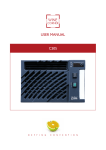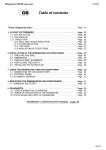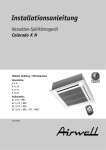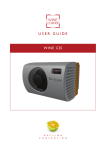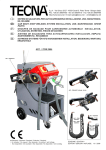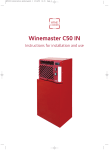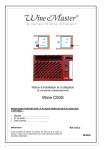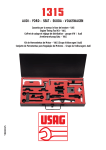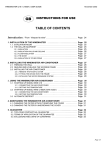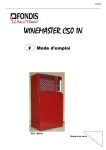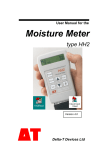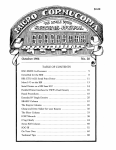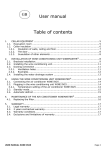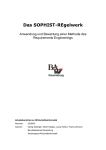Download Guide technique d'installation
Transcript
19/11/2008 WINEMASTER SP 100 Mode d’emploi Gebrauchsanweisung Instruction for use Numéro de série Seriennummer Serial number SOMMAIRE 1 CARACTERISTIQUES GENERALES ........................................................................ 4 1.1 ENCOMBREMENT : ...................................................................................................... 4 2 AMENAGEMENT DES LOCAUX ............................................................................... 5 2.1 UNITE INTERIEURE ...................................................................................................... 5 2.2 UNITE EXTERIEURE ..................................................................................................... 5 2.3 LA CAVE ........................................................................................................................ 5 2.3.1 L’ ISOLATION ................................................................................................................ 5 2.3.2 CHOIX DE L’ ISOLATION ................................................................................................. 6 2.3.3 ISOLATION DES MURS ET DU PLAFOND .......................................................................... 6 2.3.4 ISOLATION DU PLANCHER ............................................................................................. 6 2.3.5 LA PORTE ..................................................................................................................... 7 2.3.6 ISOLATION DES AUTRES ELEMENTS............................................................................... 7 3 INSTALLATION DE L’UNITE EXTERIEURE DU CLIMATISEUR ............................. 7 3.1 PERCEMENT DU MUR .................................................................................................. 7 3.2 DEMONTAGE DU FLEXIBLE ........................................................................................ 7 3.2.1 LE CAPOT ..................................................................................................................... 7 3.2.2 LES BRIDES DE MAINTIEN .............................................................................................. 8 3.2.3 LES RACCORDS FRIGORIFIQUES .................................................................................... 8 3.2.4 LE CONNECTEUR ELECTRIQUE ...................................................................................... 9 1.2 FIXATION DE L’UNITE EXTERIEURE ........................................................................... 9 3.2.5 FIXATION DU SUPPORT MURAL ...................................................................................... 9 3.2.6 ACCROCHAGE DE L’UNITE EXTERIEURE ......................................................................... 9 4 INSTALLATION DE L’ UNITE INTERIEURE ........................................................... 11 4.1 RECONNECTION DU FLEXIBLE ................................................................................ 11 4.2 MISE EN PLACE DE L’ECOULEMENT D’EAU ........................................................... 11 5 MISE EN SERVICE DU CLIMATISEUR WINESP100 .............................................. 12 5.1 BRANCHEMENT DU CLIMATISEUR .......................................................................... 12 5.2 TABLEAU DE CONTROLE .......................................................................................... 12 5.3 DEGIVRAGE AUTOMATIQUE..................................................................................... 12 6 ENTRETIEN DU CLIMATISEUR .............................................................................. 12 6.1 CHANGEMENT DU FILTRE......................................................................................... 13 7 LA GARANTIE ......................................................................................................... 14 7.1 LA GARANTIE LEGALE .............................................................................................. 14 7.2 GARANTIE CONTRACTUELLE DE 2 ANS ................................................................. 14 7.3 CONDITIONS D’ APPLICATION DE LA GARANTIE ................................................... 14 7.4 EXCLUSIONS ET LIMITES DE LA GARANTIE ........................................................... 14 2 De la vigne au vin Autrefois, on prévoyait au moment de la construction une cave qui, à elle seule, était capable de maintenir en toute saison une température n’excédant pas 14 à 16 °c. De nos jours, rares sont celles qui peuvent y prétendre. Pourtant une cave digne de ce nom doit être à l’abri des grandes variations de température, être humide à souhait mais ventilée, être obscure et ne souffrir d’aucune vibration. C’est pourquoi, depuis plus de quinze ans, entourés de spécialistes, d’amateurs passionnés et exigeants nous avons conçu, développé, éprouvé et fabriqué des milliers de climatiseurs destinés à la conservation et au vieillissement du vin. Si vous suivez nos conseils et respectez nos préconisations, vos crus pourront s’épanouir pleinement. Il est impératif de lire la notice ci-après avant d’installer et d’utiliser votre climatiseur de cave WINEMASTER FONDIS. Contactez-nous si vous avez des interrogations ! Alors... même si quelques longues années peuvent être nécessaires au vin pour atteindre sa plénitude... viendra le grand jour et pourtant toujours délicat du débouchage. Saisir délicatement le flacon... ne pas décapiter la capsule au ras de l’embouchure... s’emparer d’un bel outil à levier... arracher le bouchon sans secousse... examiner le «miroir»... Mais ceci est une autre histoire... SERVICE CLIENTS FONDIS Tél. 03.89.37.75.15/Fax 03.89.37.75.89 E-MAIL : [email protected] ª Attendre 24 heures avant de brancher le climatiseur. 3 1 CARACTERISTIQUES GENERALES Dimensions Poids Réglage de la température Température extérieure maxi Puissance frigorifique Puissance de chauffage Alimentation électrique Puissance électrique Gaz Charge de gaz Longueur du flexible utile 1005 mm x 395 mm 45 kg (int) – 15 kg(ext) Prérégler à 12°C ajustable entre 4 et 25°C* 35°C** 2500W à 12°C** 1000W 230-240V 50Hz avec prise de terre ( livré avec câble de 3 1250W R407C sans CFC 1000g 4.50 m * Avec une isolation adaptée à la température et au volume de la cave. ** La puissance diminuant en fonction de la température extérieure, l’appareil peut perdre de sa capacité à maintenir les 12°C si la température extérieure approche les 35°C. En cas de mise en sécurité thermique trop fréquente, le relais de démarrage ou le condensateur peuvent être prématurément endommagé. Dans tous les cas, il faut éviter de maintenir en permanence la température du local de rejet à 35°C, cette température élevée devant se limiter, au plus, à la saison d’été (voir §1.1 “Rejet d’air chaud”). 1.1 ENCOMBREMENT : 465mm 1005mm 435mm 360mm 395mm 480mm 4 2 AMENAGEMENT DES LOCAUX Le climatiseur est composé de deux unités séparées et relié par une liaison frigorifique et électrique souple de 5 mètres. La distance entre les deux unités ne peut donc pas dépasser 5 mètres. 2.1 UNITE INTERIEURE L’unité intérieure s’installe entièrement dans la cave à vin : posé sur le sol ou sur un support horizontal adapté au poids de l’appareil (voir § 2 “Installation du climatiseur”). 2.2 UNITE EXTERIEURE Elle doit être placée sur un mur de telle sorte que l’éjection de l’air à l’arrière de l’appareil ne soit pas perturbée par un obstacle. 2.3 2.3.1 LA CAVE L’ ISOLATION Elle est déterminante pour un bon fonctionnement du WINEMASTER. Une isolation adéquate contribuera à assurer une meilleure stabilité de la température et de l'hygrométrie. Le tableau de la page ci-après (choix de l'isolation) permet de déterminer le type et l'épaisseur d'isolant nécessaires, en fonction du volume extérieur de la cave et du modèle de WINEMASTER, pour une température intérieure de 12°C. Continuité de l'isolation : L'assemblage des éléments d'isolants doit être réalisé, de préférence par emboîtement des feuillures des panneaux ou par collage des panneaux entre eux, de façon à assurer une parfaite continuité de l'isolation. Celle-ci est très importante : elle évite les entrées parasites de chaleur et d'humidité qui nuiraient à leur régulation. IMPORTANT La validité de la garantie du WINEMASTER est liée au strict respect des valeurs du tableau de "Choix de l'isolation" pour toutes les parois de la cave y compris sol et plafond + porte ainsi qu'à la parfaite continuité de l'isolation et à une installation conforme à la notice. 5 2.3.2 CHOIX DE L’ ISOLATION E P A IS S E U R M IN IM A L E D 'IS O L A N T E N m m P O U R 1 2 ° C IN T E R IE U R E T 3 5 ° C E X T E R IE U R M OUSSE DE P O L Y U R E T H A N E λ = 0 ,0 2 5 VOLUM E DE LA PO LYSTYRENE EXPANSE PO LYSTYRENE EXTRUDE C A V E (m 3 ) λ = 0 ,0 4 4 W /m ° C λ = 0 ,0 3 0 W /m ° C W /m ° C 14 16 18 20 22 24 26 28 30 32 34 36 38 40 42 44 46 48 50 60 70 80 90 100 2.3.3 60 60 70 70 70 80 80 90 90 100 100 100 110 110 120 120 120 130 130 150 170 190 200 220 40 40 50 50 50 60 60 60 60 70 70 70 80 80 80 80 90 90 90 100 120 130 140 150 30 40 40 40 40 50 50 50 50 60 60 60 60 70 70 70 70 70 80 90 100 110 120 130 ISOLATION DES MURS ET DU PLAFOND Choix des panneaux isolants Les fabricants proposent leurs panneaux isolants sous plusieurs formes: - les isolants seuls - les "complexes" : l'isolant est revêtu d'un parement (plâtre, minéral...), - les sandwiches : Le revêtement des panneaux est important : il protège l'isolant des chocs et garantit donc sa tenue dans le temps. Ne pas utiliser d'isolants en fibres minérales (laine de verre, laine de roche, etc...), car ils peuvent se charger d’humidité et perdre leur pouvoir isolant. Protection contre les rongeurs Certains matériaux isolants sont détériorés par les rongeurs (souris, rats, ...). Il est donc nécessaire de vérifier que les parois de la cave ne présentent pas d'orifices permettant aux rongeurs d'atteindre l'isolant. Ces isolants seront revêtus, sur la face interne à la cave, d'un parement de protection. Le polyuréthane est un isolant qui, du fait de sa composition chimique, n'est pas attaqué par les rongeurs. 2.3.4 ISOLATION DU PLANCHER Le sol de la cave doit pouvoir supporter les étagères et le vin entreposé. Il est donc nécessaire, pour cette partie, de choisir un isolant présentant une résistance à la compression suffisante. Les fabricants indiquent dans leurs documentations les isolants aptes, ou destinés spécifiquement, à l'isolation des sols. La résistance à la perforation (pieds d'étagères en particulier) est obtenue : - en utilisant des panneaux isolants "complexes" revêtus, sur leur face supérieure, d'un panneau suffisamment résistant. - en doublant l'isolant d'un panneau d'aggloméré de bois (épaisseur 15 mm environ), ou de tout autre revêtement adapté (chape et dalle par exemple). 6 2.3.5 LA PORTE Elle participe à la continuité de l'isolation. Deux solutions sont possibles : - Isoler la porte existante avec un isolant du même type que pour les parois de la cave. Intercaler un joint d'étanchéité (en mousse par exemple) entre le battant et le dormant de la porte, sur toute sa périphérie. - Utiliser une PORTE ISOTHERME FONDIS, garnie de mousse polyuréthane. Elle comporte, sur toute sa périphérie, un joint d'étanchéité qui intègre une fermeture magnétique. 2.3.6 ISOLATION DES AUTRES ELEMENTS Ne pas mettre une armoire à vin ou un congélateur, qui produisent de la chaleur, dans la cave. Il faut isoler toute source de production de chaleur dans la cave, telle que les tuyaux de chauffage central. 3 INSTALLATION DE L’UNITE EXTERIEURE DU CLIMATISEUR Avant toute intervention à l’intérieure de l’unité, le câble d’alimentation doit être débranché. Assurez-vous de choisir le bon emplacement : 3.1 choisir l’endroit idéal pour que la longueur du flexible soit la plus courte possible, PERCEMENT DU MUR Le diamètre de perçage pour le passage des raccords et du flexible est de 70mm 3.2 3.2.1 DEMONTAGE DU FLEXIBLE LE CAPOT 2 1 • • Dévisser les deux vis plastique noir 1. Soulever le capot 2 en le faisant pivoter comme sur le dessin. 7 3.2.2 LES BRIDES DE MAINTIEN 2 1 3 3.2.3 Dévisser les 5 vis 1 à l’aide d’un tournevis cruciforme PZ2 pour dégager les brides de maintien 2 et 3. LES RACCORDS FRIGORIFIQUES 1 2 3 - Deux clefs 1 et 2 sont livrées avec l’appareil. - Il faut maintenir le raccord avec la clef 1 et dévisser celui-ci à l’aide de la clef 2. Attention, ne par interrompre le dévissage pendant la manipulation :du gaz peut s’échapper ! 8 3.2.4 LE CONNECTEUR ELECTRIQUE Le ventilateur de l’unité extérieur est alimenté par le câble électrique. Débrancher le connecteur 3. 1.2 FIXATION DE L’UNITE EXTERIEURE 3.2.5 FIXATION DU SUPPORT MURAL Ø10mm 150mm 300mm 443mm 3.2.6 ACCROCHAGE DE L’UNITE EXTERIEURE Avant d’accrocher l’appareil, positionner deux entretoises nylon 1 dans les trous des équerres 1 9 1 2 • Placer l’unité de condensation de façon à ce que les vis et rondelles 1 se logent dans l’ouverture 2 1 • Pour terminer, visser les ensembles vis rondelles sous l’appareil. 10 4 INSTALLATION DE L’ UNITE INTERIEURE - 4.1 poser l’appareil au sol ou sur son support horizontal, il ne doit y avoir aucun obstacle en face de la ventilation pour faciliter la circulation du flux d’air froid, le support ou le sol doit être de niveau et ne pas transmettre de vibrations. RECONNECTION DU FLEXIBLE Vous pouvez maintenant passer le flexible a travers le mur et reconnecter les raccords et le connecteur électrique en reprenant les opérations inverse des § 3.2.1. à 3.2.4. L’ordre de branchement des raccords n’a pas d’importance. Attention : les raccords doivent rester propres. Il est fortement conseillé de les recouvrir lors du passage dans la cloison. 4.2 MISE EN PLACE DE L’ECOULEMENT D’EAU 1 2 3 • • • • Visser le coude en plastique 1 En cas de nécessité étanchéifier le filetage avec du téflon Emmancher le tuyau cristal 2 Fixer le tuyau avec le collier de serrage 3 Accorder l’extrémité libre du tuyau sur un écoulement d’eau usée ou vers un bac de rétention (mini 25 litres). Eviter les « contre-pentes » ou les « siphons » 11 5 MISE EN SERVICE DU CLIMATISEUR WINESP100 L’appareil doit être installé en respectant les règles nationales d’installation électrique. Si le câble d’alimentation est endommagé, il ne doit être remplacé que par le fabricant, son SAV ou une personne de qualification similaire. 5.1 BRANCHEMENT DU CLIMATISEUR Branchez la prise mâle sur un socle de prise de courant 230V / 16 A. Mettez le climatiseur en route en appuyant sur le bouton VERT à l’arrière du climatiseur. Le ventilateur coté cave fonctionne immédiatement. Le compresseur ne peut se mettre en route qu’après 2 minutes, si la température de la cave est supérieure à la température de consigne. Si la température de la cave est inférieure ou égale au réglage du thermostat, le compresseur ne se met pas en route. 5.2 TABLEAU DE CONTROLE Le réglage de la température de consigne se fait sur le thermostat. Procédez de la manière suivante: Appuyez sur le bouton 1 une seconde jusqu’à ce que le message o1 apparaisse. En appuyant sur le bouton 3, la température de consigne clignote. Utilisez le bouton 1 pour augmenter, et le bouton 2 pour diminuer la température de consigne. Lorsque le réglage vous convient, appuyez sur le bouton 3 pour valider. 5.3 DEGIVRAGE AUTOMATIQUE Le thermostat du modèle WINEMASTER SP100 est programmé pour effectuer, à intervalle régulier, un dégivrage automatique. Cela se traduit par l’arrêt du compresseur, le ventilateur côté cave continuant à fonctionner. Les condensats éventuels, résultant du dégivrage, seront évacués par le tuyau prévu à cet effet. 6 ENTRETIEN DU CLIMATISEUR LE FILTRE A POUSSIERE Il est indispensable de remplacer le filtre à poussière qui se trouve dans la partie extérieure dès que nécessaire et au moins une fois par an. Si ce dernier est encrassé, le climatiseur risque d’être sérieusement endommagé. 12 6.1 CHANGEMENT DU FILTRE 2 1 • • • 3 Dévisser les deux vis 1. Enlever le cache en tôle 2. Tirer le filtre à l’aide de la languette 3. Remplacez-le par un filtre FONDIS exclusivement ! Vous pouvez remonter le cache en tôle. 13 7 7.1 LA GARANTIE LA GARANTIE LEGALE La garantie contractuelle n'est pas exclusive, du bénéfice au profit de l'acheteur, de la garantie légale pour défauts et vices cachés qui s'applique dans les conditions des articles 1641 et suivants du code civil. 7.2 GARANTIE CONTRACTUELLE DE 2 ANS Le climatiseur est garanti 2 ans contre tout défaut de fabrication. Durant la période de garantie contractuelle, FONDIS remplacera toute pièce reconnue défectueuse. En cas de panne électrique, FONDIS remplacera toute pièce reconnue défectueuse suite à l’intervention du revendeur qualifié ou de son intervenant. En cas de panne frigorifique, FONDIS pourra demander le retour en atelier pour réparation, suite au diagnostic effectué par le revendeur qualifié ou son intervenant. Le matériel sera tenu emballé à disposition du transporteur de FONDIS pour enlèvement. Les interventions et retours devront être réalisés après accord écrit du service après-vente FONDIS. 7.3 CONDITIONS D’ APPLICATION DE LA GARANTIE La garantie contractuelle s'applique à tous les appareils installés et utilisés conformément au "Guide d'installation et d'utilisation". Son application est conditionnée par la présentation de la facture d’achat ou à défaut de sa copie. 7.4 EXCLUSIONS ET LIMITES DE LA GARANTIE La garantie est refusée dans les cas suivants : - L'isolation de la cave et l’installation n'ont pas été effectuées conformément au présent guide. - Les avaries sont dues à une négligence, un mauvais entretien, une utilisation défectueuse ou mal adaptée du WINEMASTER. - Les échanges de pièces ou leur remise en état au titre de la garantie ne peuvent avoir pour effet de prolonger celle-ci. La Communauté Européenne accordant une grande importance à l’environnement et au traitement des déchets, a mis en place la Directive 2002/96/CE relative aux Déchets d’Equipements Electriques et Electroniques (DEEE). Conformément à cette norme, la présence du logo ″ poubelle barrée ″ est obligatoire. Ce logo signifie que ce produit ne peut être en aucun cas jeté dans les ordures ménagères. Il doit être remis à un point de collecte approprié pour le traitement, la valorisation, le recyclage des déchets d’Equipements Electriques et Electroniques. Par cette action vous faites un geste pour l’environnement et vous contribuez à la préservation des ressources naturelles ainsi qu’à la protection de la santé humaine. 14 19/11/2008 WINEMASTER SP 100 Mode d’emploi Gebrauchsanweisung Instruction for use Numéro de série Seriennummer Serial number CONTENTS 1 CHARACTERISTICS ...........................................................................................................4 DIMENSIONS : .........................................................................................................................4 2 LAYOUT OF PREMISES .....................................................................................................6 2.1 INDOOR UNIT ..........................................................................................................................6 2.2 OUTSIDE UNIT ........................................................................................................................6 2.3 THE CELLAR ...........................................................................................................................6 2.3.1 INSULATION .............................................................................................................................6 2.3.2 CHOICE OF INSULATION ..........................................................................................................7 2.3.3 WALL AND CEILING INSULATION ..............................................................................................7 2.3.4 FLOOR INSULATION .................................................................................................................7 2.3.5 THE DOOR ...............................................................................................................................8 2.3.6 INSULATION OF OTHER ITEMS..................................................................................................8 3 INSTALLING THE OUTSIDE UNIT ..................................................................................8 Make sure you have chosen the best place for fitting the outside unit : ........................................8 3.1 DRILLING THE WALL ............................................................................................................8 3.2 FLEXIBLE DISMOUNTING ...................................................................................................8 3.2.1 THE COVER ..............................................................................................................................8 3.2.2 THE FIXING BRACKETS.............................................................................................................9 3.2.3 THE REFRIGERANT CONNECTIONS ...........................................................................................9 3.2.4 ELECTRICAL CONNECTOR ......................................................................................................10 3.3 INSTALLATION OF THE OUTSIDE UNIT ..........................................................................10 3.3.1 INSTALLATION OF THE WALL MOUNTING BRACKETS ..............................................................10 3.3.2 ATTACHING THE OUTSIDE UNIT .............................................................................................10 4 INSTALLATION OF THE INSIDE UNIT .........................................................................12 4.1 RE-CONNECTION OF THE FLEXIBLE ...............................................................................12 4.2 INSTALLING THE CONDENSING WATER FLUE.............................................................12 5 USING THE WINEMASTER SP100 .................................................................................13 5.1 CONNECTING THE AIR-CONDITIONER ...........................................................................13 5.2 CONTROL PANEL .................................................................................................................13 AUTOMATIC DEFROST ...................................................................................................................13 6 SERVICING THE WINEMASTER AIR-CONDITIONER ...............................................13 6.1 CHANGING THE FILTER .....................................................................................................14 7 WARRANTY ......................................................................................................................15 7.1 YEARS CONTRACTUAL WARRANTY ..............................................................................15 7.2 TERMS OF APPLICATION OF THE GUARANTEE............................................................15 7.3 EXCLUSIONS AND LIMITS OF GUARANTEE ..................................................................15 1.1 2 FROM VINEYARD TO WINE In former times, good french cellars were built to maintain a temperature not exceeding 14 to 16°C in all seasons. Today, this is rarely the case. Nevertheless, a cellar worthy of the name must be protected against wide variations in temperature, be as damp as necessary and ventilated, dark and free of vibration. This is why, for more than fifteen years, we have used the expertise of specialists and enthusiastic amateurs to design, develop, test and produce thousands of air-conditioners destined to help in the storage and ageing of wine. If you follow our advice and respect our recommendations Winemaster will provide the optimal ageing conditions for your treasured wine collection. You have to read the installation and operating guide for your FONDIS WINEMASTER cellar air-conditioner. Contact us if you have any questions : So....even if there ay be long years to wait before the wine reaches perfection, the great day will come when you face the delicate job of uncorking. Hold the bottle carefully – do not remove the capsule on a level with the mouth – use a good quality tool or lever – remove the cork without shaking the bottle and examine the “ mirror “.. But that’s another story...... SERVICE CLIENTS FONDIS Phone 33 3 89 37 75 15/Fax 33 3 89 37 75 89 E-MAIL : [email protected] ATTENTION : Wait for 24 hours before switching on the air-conditioner. 3 1 CHARACTERISTICS Weight Dimensions Setting the temperature Electrical power Gas 45 kg (interior) – 15 kg (outside) 1005 mm x 395 mm Preset to 12°C, adjustable between 12 and 25°C* 35°C** 2500W at 12°C** 1000W 230-240V 50Hz with earth connection ( supplied with 3m cable ) 1250W R407C without CFC Refrigerant gas 1000g Length of refrigerant flexible connection 4.50 m Maximum outdoor temperature Cooling power Heating power Electricity supply The circuit breaker must be at least 16 Amps. * The insulation quality and thickness has to be in accordance with the volume of the cellar and the set temperature. ** The cooling performance is dependant from the outside temperature. Therefore, the set temperature of 12°C for the cellar cannot be maintained if the outside temperature of the cellar is maintained at 35°C. If the thermal safety functions to often, there is a risk for the condensator and starter to be damaged. In all the cases, it must be avoided that the outside temperature remains at 35°C, this high temperature should be limited to the summer period. 1.1 DIMENSIONS : 4 465mm 1005mm 435mm 360mm 395mm 480mm 5 2 LAYOUT OF PREMISES The air-conditioner is composed by two separate units which are connected by an electric and refrigerant flexible cable of 5 mts. The distance between the two units cannot be more than 5 mts. 2.1 INDOOR UNIT The indoor unit is entirely installad inside the cellar directly on the floor or fixed on the wall with adapted special brackets. 2.2 OUTSIDE UNIT The outside unit must be fixed on an outside wall in an area free from obstruction which may cause irregular air distribution and/or return in front and back of the unit. 2.3 2.3.1 THE CELLAR INSULATION Insulation of the 4 walls, the door, the ceiling and the floor is essential for the Winemaster to work properly. Adequate insulation helps to obtain the stability of the temperature and the humidity. The board on the next page ( choice of insulation ) can be used to determine the type and the thickness of insulation needed according to the internal volume of the cellar and a cellar temperature of 12°C. Insulation continuity : Insulation components must be assembled preferably by interlocking panels or glueing the panels together, to ensure perfect continuity of insulation. This is very important : it prevents heat and humidity entering from the outside which would counter the effects of regulation. IMPORTANT The validity of the WINEMASTER guarantee depends on the values in the "Choice of insulation" table being strictly respected, for all the cellar walls, including floor and ceiling + door, as well as perfect continuity of insulation and installation in accordance to the user guide. 6 2.3.2 CHOICE OF INSULATION C ELLAR V O L U M E (m 3 ) 14 16 18 20 22 24 26 28 30 32 34 36 38 40 42 44 46 48 50 60 70 80 90 100 2.3.3 M IN IM U M T H IC K N E S S O F IN S U L A T IO N (m m )fo r 1 2 ° C c e lla r te m p e r a tu r e PO LYU R ETH AN E EXPAN D ED PO LYSTYR EN E EXTR U D ED PO LYSTYR EN E λ = 0 ,0 4 4 W /m ° C λ = 0 ,0 3 0 W /m ° C F O A M λ = 0 ,0 2 5 W /m ° C 60 40 30 60 40 40 70 50 40 70 50 40 70 50 40 80 60 50 80 60 50 90 60 50 90 60 50 100 70 60 100 70 60 100 70 60 110 80 60 110 80 70 120 80 70 120 80 70 120 90 70 130 90 70 130 90 80 150 100 90 170 120 100 190 130 110 200 140 120 220 150 130 WALL AND CEILING INSULATION The manufacturers propose their insulation panels in several forms : - insulation alone - "complexes" : the insulation is lined with a facing ( plaster, mineral ….) - “ sandwiches “ : the insulation is lined on each side with a wooden or plaster panel The panel facing is important : it protects the insulation from shocks and guarantees long life. Do not use mineral fibre insulation ( glasswool, stonewool…) because it stores humidity and loose its insulation capacity. Protection against rodents Some insulating materials are damaged by rodents ( mice, rats…). It is therefore essential to make sure that the walls of the cellar do not contain holes whichf would allow rodents access to the insulation. This insulation must be lined, on the inner surface of the cellar, with a protective facing. Polyurethane insulation, because of its chemical composition, is not attacked by rodents. 2.3.4 FLOOR INSULATION The cellar floor must be able to support shelves and the wine stored on them. You should therefore choose an insulating material with adequate compression resistance for this part. Manufacturers recommend appropriate insulation or materials designed specifically for floor insulation, in their documentation. Puncture resistance ( feet of shelves in particular ) is provided : - in using "complex" insulation panels lined, on the upper surface, with a strong panel . - by facing the insulation with a panel of chipboard ( approx. 15 mm thick), or any other suitable covering plaster and slab, for example 7 2.3.5 THE DOOR It is part of the continuity of insulation. There are two possible solutions : - to insulate the existing door using the same type as insulation as was used for the cellar walls. Insert a seal such a foam, between the door panel and the frame all around the edge. - Use a FONDIS isothermal door, lined with polyurethane foam. It includes a seal around its periphery, with a magnetic closure.. 2.3.6 INSULATION OF OTHER ITEMS A fridge or another appliance producing heat must not be placed inside the cellar. For example, any hot water pipe going through the cellar must also be insulated. 3 INSTALLING THE OUTSIDE UNIT Before any intervention with interior of the unit, the electric cable must be disconnected. Make sure you have chosen the best place for fitting the outside unit : - Chose the best place in order that the length of the flexible connection will be shorter as possible. There should not be any obstacle in front of the ventilation grid and the back of the unit, to facilitate air flow The wall structure should be strong enough to carry the unit weight and avoid deformations rupture, or vibration during operation 3.1 DRILLING THE WALL Drill one hole of diametre 70mm to allow the connection of the flexible refrigerant tube to the unit. 3.2 3.2.1 FLEXIBLE DISMOUNTING THE COVER 2 1 8 • • 3.2.2 Unscrew the two black platic screws 1. Open the cover like shown on the picture 2. THE FIXING BRACKETS 2 1 3 3.2.3 Unscrew the 5 screws 1 with a screwdriver PZ2 for unmounting the brackets 2 et 3. THE REFRIGERANT CONNECTIONS 1 2 3 9 - Two wrenches 1 & 2 are supplied with the unit. - Maintain the connection with the wrenche 1and unscre with the wrenche 2. Attention : don’t stop unscrewing while gas leaks until the 2 elements are separated.The gas leak will stop then ! Before and during remounting operations, protect the end of the flexible connection in order to avoid dust goes out. 3.2.4 ELECTRICAL CONNECTOR The ventilator of the outside unit is connected by an electric cable. Disconnect the connector 3. 3.3 INSTALLATION OF THE OUTSIDE UNIT 3.3.1 INSTALLATION OF THE WALL MOUNTING BRACKETS Ø10mm 150mm 300mm 443mm 3.3.2 ATTACHING THE OUTSIDE UNIT Before attaching the outside unit, position two nylon washers 1 in the brackets holes. 1 10 1 2 • Position the outside unit so that the screws and washers 1 are engaged in the slot 2 1 • To finish, screw the kit screws and washer 1 under the unit. 11 4 INSTALLATION OF THE INSIDE UNIT - 4.1 Put the unit on the floor or on his horizontal support, It shouldn’t be any obstacle in front of the ventilation grid to facilitate the air flow The support or floor must be level and not transmit vibrations. RE-CONNECTION OF THE FLEXIBLE Pass the connecting flexible through the hole in the wall and re-connect the refrigerant fittings with the wrenches and the electrical connecting wires to the outside unit. The reconnection can be done to any pipe. Attention : open the ends of the flexible connection when you pass them through the wall in order to keep the end clean for screwing again. 4.2 INSTALLING THE CONDENSING WATER FLUE 1 2 3 • • • • Screw the plastic bend 1 supplied with the unit If necessary seal the threads with Teflon Slide the PVC tubing 2 Screw up the ring clamp 3 Connect the free end of the PVC tubing to a wastewater point or a retention tank ( mini content 25 litres). Avoid “counter slopes “ or « siphons » 12 5 USING THE WINEMASTER SP100 The Winemaster SP100 must be installed by complying with the national rules of electric installation 5.1 CONNECTING THE AIR-CONDITIONER Connect the male plug to a 230/16A power socket. Switch on the air-conditioner by pressing the green button on the back of the inside unit.. The fan on the cellar side comes on immediately. The compressor may not come on until 2 minutes later if the temperature in the cellar is higher than the set temperature. If the cellar temperature matches the thermostat setting, the compressor will not come on. 5.2 CONTROL PANEL The setting of the targeted temperature of the cellar is made on the thermostat . Use the following process : Press the button 1 one seconde until the message o1 appears. Press then the button 3, the set temperature of the cellar will appear. Use again the button 1 to increase the temperature or the button 2 to lower the temperature. When the right temperature is set, press the button 3 to confirm it. AUTOMATIC DEFROST The program of the thermostat from model WINEMASTER SP100 will run an automatic defrost time several times a day. During this position, the compressor stops and only the fan in the cellar is functionning. The condensate water produced during this period will b evacuated through the tube. 6 SERVICING THE WINEMASTER AIR-CONDITIONER THE DUST FILTER It is essential to replace the dust filter in the air-conditioner as soon as necessary and at least once a year. If it is clogged, the air-conditioner could be seriously damaged. 13 6.1 CHANGING THE FILTER 2 1 • • • 3 Unscrew the two plastic screws 1 Remove the cover 2. Pull the tab 3 to release the filter Replace it with a FONDIS filter only ! You can then replace the cover. 14 7 7.1 WARRANTY YEARS CONTRACTUAL WARRANTY The air-conditioner is guaranteed for two years against manufacturing defects. During the contractual guarantee period, FONDIS will replace any part recognized as defective, following the intervention of a qualified representative. In the event of an electrical breakdown, FONDIS will replace any part recognized as defective following the intervention of a qualified stockist or his representative. In the event of cooling system breackdown, FONDIS can ask for the part to be returned for repair following the intervention of a qualified representative. The equipment will be packed and held available for the FONDIS carrier to collect it. Operations and returns must be made with the written agreement of FONDIS after sales service. 7.2 TERMS OF APPLICATION OF THE GUARANTEE The contractual guarantee applies to all devices installed and used in accordance with the « installation and operating guide ". His application is conditionned by the presentation of the invoice of purshace or for lack of its copy. 7.3 EXCLUSIONS AND LIMITS OF GUARANTEE The guarantee is refused in the following cases : - The cellar and installation have not been insulated in accordance with this guide. - The damage is due to negligence, poor maintance, defective or inappropriate use of the Winemaster - Part exchanges or remplacements under guarantee will not have the effect of extending it. The European Community attaching a great importance to the environment and the waste processing, set up Directive 2002/96/CE relating to the Electric and Electronic Component Waste. In accordance with this standard, the presence of the logo "barred dustbin" is obligatory. This logo means that this product cannot be to in no case thrown in the household refuse. It must be given to a suitable collection point for the treatment, valorization, recycling of Electric and Electronic Components. Acting like that you make a gesture for the environment and you contribute to the safeguarding of the natural resources as well as to the protection of human health. 15 19/11/2008 WINEMASTER SP 100 Mode d’emploi Gebrauchsanweisung Instruction for use INHALTSVERZEICHNIS 1 TECHNISCHE DATEN 1.1 MASSE 2 EINRICHTUNG DES WEINKELLERS 2.1 Innen-Gerät 2.2 Aussen-Gerät 2.3 Ausstattung des Weinkellers 2.3.1 Wärmedämmung 2.3.2 Wahl der Wärmedämmung 2.3.3 Wärmedämmung des Bodens 2.3.4 Die Tür 3 ANBAU DES AUSSENTEILS 3.1 Wanddurchbruch 3.2 ABBAUEN DES SCHLAUCHES 3.2.1 ABDECKUNG 3.2.2 HALTEFLANSCHE 3.2.3 KÜHLANSCHLÜSSE 3.2.4 ELEKTRISCHER STECKVERBINDER 3.2.5 BEFESTIGUNG DER WANDHALTERUNG 3.2.6 EINHÄNGEN DES AUSSENTEILS 4 EINBAU DES INNENTEILS 4.1 WIEDERANSCHLIESSEN DES SCHLAUCHES 4.2 ANBRINGEN DER KONDENSWASSERABLEITUNG 5 INBETRIEBNAHME DES WINEMASTER SP 100 5.1 ANSCHLIESSEN DES KLIMAGERÄTES 5.2 BEDIENUNGSFELD 5.3 AUTOMATISCHES ENTEISEN 6 WARTUNG DES KLIMAGERÄTES 6.1 AUSWECHSELN DES FILTERS 7 GARANTIE 7.1 ZWEIJÄHRIGE VERTRAGSGARANTIE 7.2 VORAUSSETZUNGEN FÜR DIE GÜLTIGKEIT DER GARANTIE 7.3 AUSSCHLÜSSE UND BEGRENZUG DER GARANTIE GARANTIESCHEIN Seite 4 Seite 4 Seite 5 Seite 5 Seite 5 Seite 5 Seite 5 Seite 5 Seite 6 Seite 6 Seite 7 Seite 7 Seite 7 Seite 7 Seite 7 Seite 8 Seite 9 Seite 10 Seite 11 Seite 11 Seite 11 Seite 11 Seite 12 Seite 12 Seite 12 Seite 12 Seite 12 Seite 13 Seite 14 Seite 14 Seite 14 Seite 14 Seite 15 2 VOM REBSTOCK ZUM WEIN Früher baute man Häuser, in denen auch ein Keller vorgesehen war, in dem die Temperatur das ganze Jahr über relativ konstant blieb – im Durchschnitt zwischen 14 und 16°C. Heute stellt dieser Fall eher eine Ausnahme dar. Wenn man sich jedoch einen richtigen Weinkeller einrichten will, so darf dieser keine starken Temperaturschwankungen, jedoch eine leichte Luftfeuchtigkeit aufweisen, soll gut durchlüftet, möglichst dunkel und keinerlei Vibrationen ausgesetzt sein. Daher wurden bei der Fa. FONDIS seit über 15 Jahren in Zusammenarbeit mit Fachleuten auf dem Gebiet und anspruchsvollen Weinliebhabern tausende von Klimageräten geplant, entwickelt, erprobt und gebaut, die ein einwandfreies Lagern und Reifen der Weine gewährleisten. Wenn Sie unsere Ratschläge befolgen und unsere Vorschriften beachten, können Sie Ihre edlen Tropfen in aller Ruhe lagern und reifen lassen. Lesen Sie die Einbau- und Betriebsanleitung Ihres Klimagerätes für Weinkeller WINEMASTER der Fa. FONDIS sorgfältig durch. Wenden Sie sich an uns, wenn Sie Fragen haben! Auch wenn es mehrere Jahre erfordert, um manchen Wein zur vollen Reife zu bringen, können Sie mit dem WINEMASTER in aller Ruhe auf den großen Tag warten, an dem Sie eine besonders gute Flasche aus Ihrem Weinkeller holen können. Nehmen Sie die Flasche behutsam vom Regal, ohne sie zu schütteln, entfernen Sie die Kapsel am Flaschenrand, greifen Sie zum Korkenzieher und ziehen Sie den Korken langsam und ohne Rucken heraus, prüfen Sie den „Spiegel“ daran und … Aber das ist eine andere Geschichte … FONDIS KUNDENDIENST Tel. (0)389 377 500 - Fax (0)389 377 589 E-Mail : [email protected] Wichtig : Vor der Inbetriebnahme des Klimagerätes 24 Stunden warten. 3 1 TECHNISCHE DATEN Abmessungen 1005 mm x 395 mm Weight 45 kg (int) – 15 kg(ext) Temperatureinstellung Werkseitig auf 12° eingestellt, regelbar zwischen 4°C&25°C Maxi Aussentemperatur Kühlleistung Kälteleistung Stromversorgung Leistungsaufnahme Gas Gasfühlung Schlauchlänge 35°C ** 12°C** 2500W 230-240 V - 50 Hz - mit Erdung (mit 3m Kabel geliefert) 1250W R407C ohne CFC 1000g 4.5 m Der Schaltautomat muss mindestens für 16 Ampere ausgelegt sein. * Die Isolation soll im Verhältniss mit Raumvolumen und der gewählten Innentemperatur sein. ** Die Leistung ist von der Aussentemperatur abhängig. Das Gerät kann deswegen nicht unbedingt die Innentemperatur von 12°C einhalten wenn die Aussentemperatur 35°C erreicht. Wenn die thermische Sicherung zu oft ausfällt können die Kondensatoren und der Starter beschädigt werden. In jedem Fall, muss man vermeiden, dass die Tempartur im Aussenraum ständig bei 35°C bleibt. Diese hohen Temparaturen sollten sich in den Sommerzeiten begrenzen. 1.1 MASSE : 465mm 1005mm 435mm 360mm 395mm 480mm 4 2 EINRICHTUNG DES WEINKELLERS Die Klimaanlage besteht aus 2 separaten Geräten welche mit einem 5 m Kühlungsschlauch verbunden sind. Die 2 Geräte dürfen nicht mehr als 5 m von einander entfernt stehen. 2.1 INNEN-GERÄT Das Innengerät wird im Inneren des Weinkellers eingerichtet : Auf dem Boden oder auf einem waagerechten Ständer. 2.2 AUSSEN-GERÄT Wird auf einer Aussenmauer eingerichtet frei von alle An - oder Zuluftstörungen . .2.3 AUSSTATTUNG DES WEINKELLERS 2.3.1 WÄRMEDÄMMUNG Sie muss eingebaut sein auf allen Seiten, Wände, Decke und Boden für den einwandfreien Betrieb des Winemasters. Bei richtiger Wärmedämmung ergibt sich eine bessere Stabilität der Temperatur und der Luftfeuchtigkeit. Anhand der nachfolgenden Tabelle, “Wahl der Wärmedämmung“ können Art und Stärke der Dämmschicht nach Aussenabmessungen des Raumes für eine Kellertemperatur von 12°C bestimmt werden.. Durchgehende Wärmedämmung: Die einzelnen Elemente der Wärmedämmung müssen durch Ineinanderschieben von Nut und Feder bzw. Verkleben der Dämmplatten zusammengefügt werden, so dass eine durchgehende Wärmedämmung gewährleistet ist. Dieser Punkt ist sehr wichtig, da das Eindringen von Wärme oder Feuchtigkeit den einwandfreien Betrieb des Klimagerätes beeinträchtigen kann. 2.3.2.WAHL DES WINEMASTERS UND DER WÄRMEDÄMMUNG WICHTIG Die Garantie für den WINEMASTER hat nur dann Gültigkeit, wenn die in der Tabelle „Wahl der Wärmedämmung“ angegebenen Werte an allen Wandflächen des Raumes – einschließlich Decke, Boden und Tür - eingehalten werden und eine durchgehende Wärmedämmung gewährleistet ist. WAHL DER WÄRMEDÄMMUNG 5 VOLUM EN DES R A U M S (m 3 ) 14 16 18 20 22 24 26 28 30 32 34 36 38 40 42 44 46 48 50 60 70 80 90 100 M IN D E S T S T Ä R K E D E R D Ä M M S C H IC H T in m m fo r 1 2 ° C K e lle r te m p e r a tu r G ESCHÄUM TES STYO PO R E X T R U D IE R T E S S T Y R O P O R λ = 0 ,0 4 4 W /m ° C λ = 0 ,0 3 0 W /m ° C P U -S C H A U M λ = 0 ,0 2 5 W /m ° C 60 60 70 70 70 80 80 90 90 100 100 100 110 110 120 120 120 130 130 150 170 190 200 220 40 40 50 50 50 60 60 60 60 70 70 70 80 80 80 80 90 90 90 100 120 130 140 150 30 40 40 40 40 50 50 50 50 60 60 60 60 70 70 70 70 70 80 90 100 110 120 130 . 2.3.3 WÄRMEDÄMMUNG DES BODENS Der Boden des Weinkellers muss die Weinregale usw.tragen können. Daher ist für diesen Teil des Weinkellers ein Dämmmaterial zu wählen, das ausreichend fest gegen die auftretende Druckbelastung ist. Die Hersteller von Dämmstoffen geben in Ihrer Dokumention an, welche Produkte speziell für solche Beanspruchungen geeignet sind. Der Schutz der Bodenverkleidung vor dem Durchstossen ( insbesondere durch die Füsse der Regale ) kann folgendermassen werden : - Durch komplexe Dämmplatten die auf der Oberseite mit einer ausreiched festen Platte verkleidet sind. - Durch Abdecken der Dämmschicht mit einer Spanplatte ( mit ca.15 mm Stärke ). 2.3.4 DIE TÜR Sie muss fester Bestandteil der durchgehenden Wärmedämmung sein. Dabei sind zwei Lösungen möglich : - Wärmedämmung der vorhanden Tür mit einem Dämmstoff derselben Art wie bei den Wänden und der Decke - Dabei auch eine umlaufende Dichtung ( z.B.aus Schaumstoff ) zwischen Türblatt und Türrahmen einsetzen - Einbau einer wärmedämmenden Tür von FONDIS die mit einer Schicht PU-Schaum versehen ist und eine umlaufende Dichtung sowie einen magnetischen Türverschluss besitzt. 6 3. ANBAU DES AUSSENTEILS Vor jedem Eingriff in das Innere des Geräts, das Netzkabel muss getrennt werden. Auf günstigen Einbauort achten: - Technisch am idealsten ist der Einbau, bei dem die Schlauchlänge am kürzesten ist. 3.1 WANDDURCHBRUCH Der Durchmesser der Öffnung zum Durchführen der Anschlüsse und des Schlauchs beträgt 70 mm. 3.2 ABBAUEN DES SCHLAUCHES 3.2.1 ABDECKUNG • Die 2 schwarzen Plastikschrauben 1 abschrauben. • Die Abdeckung 2, wie auf der Zeichnung dargestellt, abnehmen. 2 1 3.2.2 HALTEFLANSCHE - Die 5 Schrauben 1 mit einem Kreuzschraubendreher PZ2 lösen um die beiden Halteflansche 2 und 3 abzunehmen. 7 2 1 3 3.2.3 KÜHLANSCHLÜSSE - Die zwei Maulschlüssel 1 und 2 sind mitgeliefert. - Den Anschluss mit dem Schlüssel 1 festhalten und mit dem Schlüssel 2 abschrauben. 1 2 3 Achtung: Die Arbeit während des Abschraubens nicht unterbrechen, da Gas entweichen kann! 8 3.2.4 ELEKTRISCHER STECKVERBINDER Der Ventilator des Außenteils wird mit Strom versorgt. Den Steckverbinder abklemmen. 3.2.5 BEFESTIGUNG DER WANDHALTERUNG Ø10mm 150mm 300mm 443mm 3.2.6 EINHÄNGEN DES AUSSENTEILS Vor dem Einhängen des Gerätes, die beiden Abstandhalter aus Nylon 1 in die Bohrungen in den Winkeleisen einsetzen. 1 9 1 2 • Das Kondensationsgerät so anbringen, dass die Schrauben und U’Scheiben 1 in der Aussparung 2 einhaken 2 1 • Abschließend die Schrauben mit den U’Scheiben auf der Unterseite des Gerätes anschrauben. 10 4. EINBAU DES INNENTEILS - Das Gerät auf dem Boden oder einer waagrechten Fläche abstellen. Es darf sich kein Hindernis vor der Luftaustrittsöffnung befinden, um das ungehinderte Ausströmen der Kaltluft zu gewährleisten. Die Auflage bzw. der Boden muss waagrecht sein und darf keine Schwingungen übertragen. 4.1 WIEDERANSCHLIESSEN DES SCHLAUCHES Anschließend kann der Schlauch durch den Wanddurchbruch gezogen und die Anschlüsse sowie der Steckverbinder angeschlossen werden. Dazu die Arbeitsschritte nach 3.2.1 bis 3.2.4 in umgekehrter Reihenfolge durchführen. Die Anschlüsse können in beliebiger Reihenfolge vorgenommen werden. Achtung: Die Medienanschlüsse müssen stets sauber bleiben. Es empfiehl sich, sie vor dem Durchführen durch die Wand abzudecken. 4.2 ANBRINGEN DER KONDENSWASSERABLEITUNG 1 2 3 • • • • Den Krümmer aus Kunststoff 1 einschrauben Wenn notwendig, das Gewinde mit Teflon verdichten Das Kristallrohr 2 aufsetzen Den Schlauch mit den Schlauchklemmen 3 befestigen. Das freie Ende des Schlauches in eine Ableitung oder einen Auffangbehälter (min. 25 Liter) legen. Dabei auf möglichst gerades Verlegen (keine Siphon- und Schleifenbildung) achten. 11 5. INBETRIEBNAHME DES WINEMASTER SP100 Das Gerät sollte eingerichtet werden, die den nationalen Vorschriften des elektrischen Anlage. Wenn das Netzkabel beschädigt ist, darf er ersetzt werden, die vom Hersteller, seinem Kundendienst oder eine Person, die Qualifikation ähnlich. 5.1 ANSCHLIESSEN DES KLIMAGERÄTES Den Gerätestecker an einer Wandsteckdose (230 V – 16 A) anschließen. Das Klimagerät durch Drücken der GRÜNEN Taste auf der Rückseite des Geräts in Betrieb setzen. Der Ventilator auf der Innenseite beginnt sich sofort zu drehen. Wenn die Temperatur im Weinkeller höher als die Vorgabetemperatur ist, wird der Kompressor nach einer Verzögerung von 2 Minuten eingeschaltet. Ist die Innentemperatur kleiner oder gleich der Vorgabetemperatur, so bleibt er abgeschaltet. 5.2 BEDIENNUNGSFELD Das Einstellen der Vorgabetemperatur erfolgt am Thermostat . Dazu wie folgt vorgehen: Taste 1 eine Sekunde lang gedrückt halten, bis „01“ angezeigt wird. Danach die Taste 3 drücken, worauf die Temperaturanzeige blinkt. Nun kann die Vorgabetemperatur mit den Tasten 1 (höher) und 2 (niedriger) eingestellt werden. Zum Bestätigen des eingestellten Wertes erneut die Taste 3 drücken. 5.3 AUTOMATISCHES ENTEISEN Der Thermostat des Modells WINEMASTER SP100 ist so programmiert, dass in regelmäßigen Intervallen ein automatisches Enteisen durchgeführt wird. Dazu wird der Kompressor abgeschaltet, während der Ventilator auf der Innenseite weiter läuft. Wenn beim Enteisen Kondenswasser anfällt, wird dieses über den angebauten Schlauch abgeleitet. 6. WARTUNG DES KLIMAGERÄTES STAUBFILTER Der Staubfilter im Außenteil muss ausgewechselt werden, sobald dies notwendig ist, mindestens jedoch einmal pro Jahr. Bei zu starker Verschmutzung des Filters kann das Gerät ernsthaft beschädigt werden. 12 6.1 AUSWECHSELN DES FILTERS 2 1 • • • 3 Die beiden Schrauben 1 abschrauben. Die Blechabdeckung 2 entfernen. Den Filter an der Lasche 3 herausziehen. Zum Auswechseln ausschließlich Original FONDIS-Filter verwenden! Anschließend die Abdeckung wieder anschrauben. 13 7 GARANTIE 7.1 ZWEIJÄHRIGE VERTRAGSGARANTIE Auf das Klimagerät wird eine zweijährige Garantie für Fertigungsfehler erteilt. In der Garantiezeit werden alle als fehlerhaft anerkannten Teile von der Fa.Fondis ersetzt. Bei Mängeln an elektrischen Komponenten werden alle als fehlerhaft anerkannten Teile nach den entsprechenden Reparaturarbeiten des qualifizierten Händlers oder dessen Beauftragten von der Fa.FONDIS ersetzt. Bei Mängeln am Kühlaggregat kann die Firma FONDIS die Rücksendung des Gerätes zu Reparaturzwechen nach der Diagnose des qualifizierten Händlers oder dessen Beauftragten verlangen. Dazu ist das Gerät dem Transportunternehmen der Fa.Fondis ordnungsgemäss verpackt zum Abholen bereit zu stellen. Vor Reparaturarbeiten bzw. Rücksendungen ist die schriftliche Zustimmung des FONDIS –Kundendienstes einzuholen. 7.2 VORAUSSETZUNGEN FÜR DIE GÜLTIGKEIT DER GARANTIE Die Vertragsgarantie gilt für alle Klimageräte, die sachgerecht, d.h. nach den Vorgaben in der „Einbau-und Betriebsanleitung“ installiert und betrieben werden. Damit die Garantie in Kraft tritt, muss der Garantieschein am Ende der Anleitungsbroschüre innerhalb von 3 Wochen nach dem Kaufdatum an Fondis zurückgeschickt werden. 7.3.AUSSCHLÜSSE UND BEGRENZUG DER GARANTIE In folgenden Fälle ist die Garantie ausgeschlossen : Unsachgemässe bzw.fehlende Wärmedämmung des Weinkellers nach den Vorgaben in dieser Anleitung Mängel, die durch Nachlässigkeit, unzureichende Wartung, unsachgemässen Betrieb oder Benutzung des Winemasters zu anderen Zwecken als den vorgesehenen verursacht wurden. Bei Austausch oder Reparatur von Geräteteilen im Rahmen der Garantie wird die Garantiezeit insgesamt nicht verlängert. Die Fa.Fondis kann nicht durch Betriebsausfälle des Klimagerätes verursachte direkte und indirekte Schänden haftbar gemacht werden. Die Garantie ist aussschliesslich auf das von der Fa.FONDIS gelieferte Produkt begrenzt. 14 GARANTIESCHEIN FÜR WINEMASTER FONDIS Damit Ihre vertragliche 2-Jahres-Garantie wirksam werden kann, müssen Sie gemäß den in der Gebrauchsanleitung beschriebenen Bedingungen diesen Garantieschein ausfüllen und innerhalb von 2 Wochen nach dem Kaufdatum an FONDIS einsenden. Sie können den Garantieschein in einem frankierten Umschlag an folgende Adresse schicken : FONDIS S.A. F - 68801 THANN CEDEX STEMPFEL DES FACHGESCHÄFTES MODELL SERIENNUMMER KAUFDATUM NAME ........................................................... VORNAME ............................................... ADRESSE....................................................................................................................... ..................................................................................................................................... PLZ ........................ ORT ..................................................LAND ................................. Bitte, geben Sie hier an, wie Ihre Weinklimaanlage installiert wurde. Beschaffenheit der Dämmung Klimatisierter Rauminhalt: . . . . . . . m3 Materialbeschreibung und Dicke Art des Dämmstoffs und Dicke Wände Boden Decke Tür Wie sind Sie auf WINEMASTER von FONDIS aufmerksam geworden ? Durch meinen Fachhändler Auf einer Verbrauchermesse Durch einen Zeitungsartikel Durch Werbung Sonstiges (bitte erläutern) : 15












































